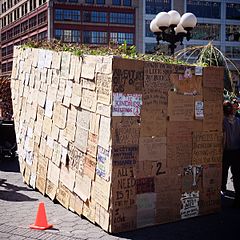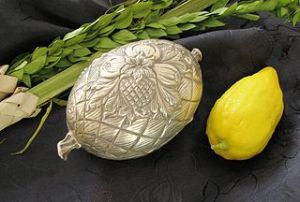
Wikimedia Commons: Matthew McDermott
Sukkot, the roughly week-long Jewish holiday also known as the Festival of Booths, is coming to a close. Unlike Yom Kippur, which is a solemn holiday that focuses on atonement for our sins, Sukkot is a joyous occasion — a fall harvest festival that also honors the memory of the Israelites who wandered in the desert for 40 years. I was able to participate in two wonderful holiday rituals over the weekend. Both allowed me to shake my lulav — up and down and front and back – literally and metaphorically.
While the holiday itself is known as Sukkot*, the booth or temporary shelter is known as a sukkah. They are constructed by many Jewish communities and families. In fact, if you drove by a local synagogue during the last week, you probably saw one. The sukkah generally has four walls – one of which might be the exterior wall of a building – and those walls can be made of almost anything, including cardboard, bed sheets, and PVC pipe. Some shelters look like they will barely last the week. Others, especially those made from kits, are quite sturdy. Both shelters I visited last weekend looked like they were made from kits. At our Conservative synagogue, the sukkah was free-standing. The frame was made of lightweight steel tubing and the walls were lightweight canvas. At our Orthodox Chabad house, the sukkah was also free-standing. The frame was aluminum, and the sides looked like they were made of fiberglass. If you’re interested, do a quick internet search on “sukkah” or “sukkah kits.” Just looking at the images will give you an immediate sense of the range of options. It’s pretty impressive!
The roof of the sukkah is made of raw vegetable matter. Practically speaking, this refers to things like bamboo, palm fronds, or leafy tree branches. Ideally, the entire structure is under the open sky with nothing else (like eaves or tree branches) hanging over it. Since people eat, and even sleep, in the sukkah, the inside is often furnished with tables, chairs, and some form of lighting. Those are the basic parameters, although there are several additional guidelines for those who want to be entirely “kosher” when building a sukkah.
Sukkot is a great holiday for kids. The temporary shelter is like a fort or a tent, which is always fun, but the sukkah can also be decorated. Of course, you can buy decorations, but making decorations is a great way to get kids involved in the festivities. They can draw pictures and hang them on the inside walls. They can make construction paper chains and drape them from one corner to the other. They can also make hanging decorations. One year, the kids here at Jubilee! Community Church colored images of fruit photocopied onto cardstock. We punched a hole in the top, tied on a longish piece of yarn through the hole, and hung them from the frame of the bamboo sukkah “roof” hovering above the altar in our sanctuary.
The Festival of Booths is described or mentioned in several books of the Hebrew Bible, including all five books of the Torah except Genesis. Here is a portion of the text from Leviticus.
The L-rd spoke to Moses, saying: Speak to the people of Israel, saying: On the fifteenth day of this seventh month, and lasting seven days, there shall be the festival of booths to the L-rd. The first day shall be a holy convocation; you shall not work at your occupations…. On the first day you shall take the fruit of majestic trees, branches of palm trees, boughs of leafy trees, and willows of the brook; and you shall rejoice before the L-rd your G-d for seven days…. You shall live in booths for seven days; all that are citizens in Israel shall live in booths, so that your generations may know that I made the people of Israel live in booths when I brought them out of the land of Egypt: I am the L-rd your G-d. (Leviticus 23:33-35, 40, 42-43)
Many Christian groups also celebrate Sukkot, in large part because there is a story in the Gospel of John about Jesus attending the festival. According to the story, Jesus’ brothers encouraged him to attend the festival, but he declined. Later, Jesus apparently had a change of heart because he decided to show up.
But after his brothers had gone to the festival, then [Jesus] also went, not publicly but as it were in secret. The Jews were looking for him at the festival and saying, “Where is he?” And there was considerable complaining about him among the crowds. While some were saying, “He is a good man,” others were saying, “No, he is deceiving the crowd.” (John 7:10-12)
But what does any of this have to do with me shaking my lulav?!
On Saturday evening, I attended a Sukkot Music Jam in the sukkah at the conservative temple. We all circled up in chairs. Various people came equipped with guitars and drums. For the rest of us, a duffle bag full of egg-shaped shakers was passed around. The natural light faded and the electric lights of the sukkah became more prominent as the sun set and Shabbat came to a close. We sang folk songs, spirituals, Hebrew prayers, and Jewish camp tunes. Since singing is my favorite spiritual practice, I had a great time! It felt just like camp – without the campfire. And of course, there was a song about the lulav! The English words are:
Shake your lulav up and down
East and west and north and south
Shake your lulav up and down
East and west and all around
Before you get the wrong idea, a “lulav” is a braided bunch of branches. Technically, the Hebrew word “lulav” refers to the frond of the date palm. However, at Sukkot, the date palm is braided together with branches of willow and myrtle (see Leviticus again for references). The entire unit is called a lulav since the palm frond is the longest. Jewish people wave the braided branch to the right, to the left, toward the front, up, down, and then back over their shoulders while reciting a blessing. The blessing can be translated roughly as “Blessed are You, L-rd our G-d, King of the Universe, who has sanctified us with His commandments and has commanded us concerning the waving of the lulav.” There is a great deal of rabbinical commentary on the meaning behind various aspects of Sukkot, but I’ve heard it said that shaking the lulav in all directions is a great reminder that G-d is everywhere.
On Sunday, I attended the Chabad House Sukkah Social. It was a beautiful fall day here, and when I pulled up to the center, I could tell the kids were having trouble deciding how to spend their time – eating kosher pizza in the sukkah or jumping in the bouncy house sitting next to it. The rabbi was leading lulav-/etrog-shaking blessings just outside the sukkah, and tables inside the synagogue were set up for making stuffed Torah crafts. The etrog is another important aspect of Sukkot. The etrog is a yellow citrus fruit that is a bit larger and more wrinkly than a lemon. It represents the “fruit of the majestic trees” mentioned in the Leviticus passage above. In addition to shaking the lulav, one also holds an etrog. They grow in a variety of places, but most American Jews import them from Israel. The etrog, together with the braided lulav, are referred to as the Four Kinds. They represent the various types of Jewish practice found in the Jewish community, all of which have something valuable to offer.

Wikimedia Commons: Gilabrand
Clearly, Sukkot is a fun holiday that provides a great opportunity for you and your kids to learn a bit about the agricultural and historical mindset of the Jewish faith. It’s mitzvah (duty) for all members of the Jewish community to shake the Four Kinds during each of the middle days of Sukkot. It’s also mitzvah for them to invite others to the sukkah. So make it easy on your Jewish friends next year. Check the web sites of your local synagogues and see which events you might attend. I can assure you that if you just show up, your entire family will have a wonderful time. It’s a holiday full of fun, gratitude, picnicking, and remembrance. Plus, you’ll get to shake your lulav — back and forth and up and down.
*The Hebrew pronunciation for Sukkot is something like sue-COAT, but you’ll also hear it pronounced SOO-cut (where the “oo” sound rhymes with look)
Source
Holy Bible: New Revised Standard Version. San Francisco, CA: HarperOne, 2007. Print.
Related Videos
Rob Amchin teaching students at Univ. of Louisville Ha Sukkah Ma Yafa (the shake-your-lulav song)
Shakin’ the Lulav (Sukkot song) – a very funny parody of Twist and Shout